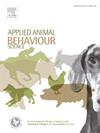Grazing time of dairy cows recorded using two devices based on accelerometers
IF 2.2
2区 农林科学
Q1 AGRICULTURE, DAIRY & ANIMAL SCIENCE
引用次数: 0
Abstract
Investigating grazing behaviour of dairy cattle requires accurately recording their daily grazing time. Unfortunately, commercially available devices are often not validated for the degree of precision required in animal science at the cow × day level. In two studies, the ability of the Feed’Live® device (New Medria) to accurately estimate daily grazing time of dairy cows was investigated. It contains a triaxial accelerometer whose raw data, once processed by New Medria, provides the dominant activity for 5-min periods: intake, rumination, overactivity or other activity. Feed’Live data were compared to those from the Lifecorder Plus (Kenz) device, which contains a uniaxial accelerometer, used in the study as reference values for actual grazing time due to its known high accuracy thanks to a large external validation. Twenty four dairy cows were simultaneously equipped with both devices for several weeks in study 1 (spring 2021) and study 2 (spring 2022), for a total of 1224 cow × day datapoints. Daily access time to pasture was either 19 h/day (861 cow × day datapoints) or 7 h/day (363 cow × day datapoints) according to the experimental treatments investigated. On the whole database, compared to the Lifecorder Plus, Feed’Live underestimated daily grazing time by 15 % (65 min/day), with a lower underestimation for cows having 19 h/day of access to pasture (11 %, 48 min/day), and a greater underestimation for cows having only 7 h/day of access to pasture (31 %, 107 min/day). The bias in the estimated grazing time between the two devices was strongly and positively correlated with the time of other activity. This is because Feed’Live failed to identify grazing as the main activity during several grazing sequences and sometimes missed entire grazing sequences. Most of the grazing activity that the Feed’Live failed to detect was classified as other activity, with no misclassification as rumination. Correcting grazing time by adding other activity time to it provided a much more accurate estimate of actual grazing time, with no more bias and an average mean prediction error of only 9 % at the cow × day level vs. 23 % without correction on the entire database. For cows having access to pasture only during daytime, the mean prediction error was reduced from 40 % to 6 % thanks to this correction. For scientific purposes, when data are available, actual grazing time can thus be estimated accurately by the Feed’Live by summing the times of grazing and other activity.
使用两个基于加速度计的设备记录奶牛的放牧时间
调查奶牛的放牧行为需要准确记录它们每天的放牧时间。不幸的是,商业上可用的设备通常无法在奶牛× 日水平上验证动物科学所需的精确度。在两项研究中,研究了Feed 'Live®设备(New media)准确估计奶牛每日放牧时间的能力。它包含一个三轴加速度计,其原始数据经新媒体处理后,提供5分钟内的主要活动:进食、反刍、过度活动或其他活动。将Feed的实时数据与Lifecorder Plus (Kenz)设备的数据进行比较,后者包含一个单轴加速度计,在研究中用作实际放牧时间的参考值,因为由于大量的外部验证,它具有众所周知的高精度。在研究1(2021年春季)和研究2(2022年春季)中,24头奶牛同时配备这两种设备数周,总共1224头奶牛× 天数据点。根据所调查的试验处理,日放牧时间为19 h/d(861头×天数据点)或7 h/d(363头×天数据点)。在整个数据库中,与Lifecorder Plus相比,Feed 'Live低估了每日放牧时间15 %(65 分钟/天),对19 小时/天的奶牛的低估程度较低(11 %,48 分钟/天),对7 小时/天的奶牛的低估程度较高(31 %,107 分钟/天)。两个装置之间估计放牧时间的偏差与其他活动的时间呈强烈的正相关。这是因为在几个放牧序列中,Feed 'Live未能将放牧识别为主要活动,有时会错过整个放牧序列。大多数没有被Feed 'Live检测到的放牧活动被归类为其他活动,没有被错误地归类为反刍。通过添加其他活动时间来校正放牧时间,可以更准确地估计实际放牧时间,没有更多的偏差,在奶牛× 天水平上的平均预测误差仅为9 %,而在整个数据库上未经校正的平均预测误差为23 %。对于只在白天放牧的奶牛,由于这一修正,平均预测误差从40 %减少到6 %。为了科学目的,当数据可用时,实际放牧时间可以通过饲料直播通过放牧和其他活动的总和来准确估计。
本文章由计算机程序翻译,如有差异,请以英文原文为准。
求助全文
约1分钟内获得全文
求助全文
来源期刊

Applied Animal Behaviour Science
农林科学-行为科学
CiteScore
4.40
自引率
21.70%
发文量
191
审稿时长
18.1 weeks
期刊介绍:
This journal publishes relevant information on the behaviour of domesticated and utilized animals.
Topics covered include:
-Behaviour of farm, zoo and laboratory animals in relation to animal management and welfare
-Behaviour of companion animals in relation to behavioural problems, for example, in relation to the training of dogs for different purposes, in relation to behavioural problems
-Studies of the behaviour of wild animals when these studies are relevant from an applied perspective, for example in relation to wildlife management, pest management or nature conservation
-Methodological studies within relevant fields
The principal subjects are farm, companion and laboratory animals, including, of course, poultry. The journal also deals with the following animal subjects:
-Those involved in any farming system, e.g. deer, rabbits and fur-bearing animals
-Those in ANY form of confinement, e.g. zoos, safari parks and other forms of display
-Feral animals, and any animal species which impinge on farming operations, e.g. as causes of loss or damage
-Species used for hunting, recreation etc. may also be considered as acceptable subjects in some instances
-Laboratory animals, if the material relates to their behavioural requirements
 求助内容:
求助内容: 应助结果提醒方式:
应助结果提醒方式:


